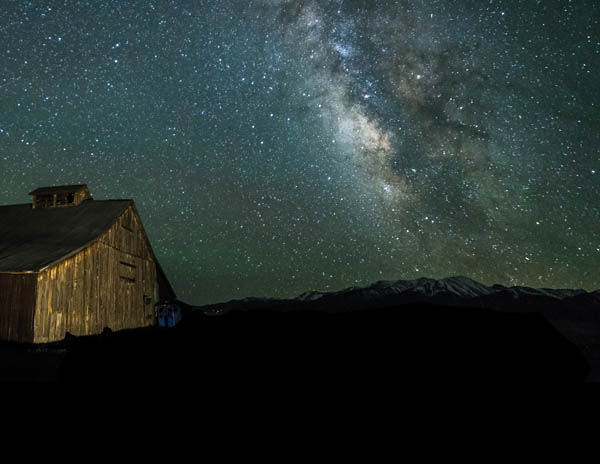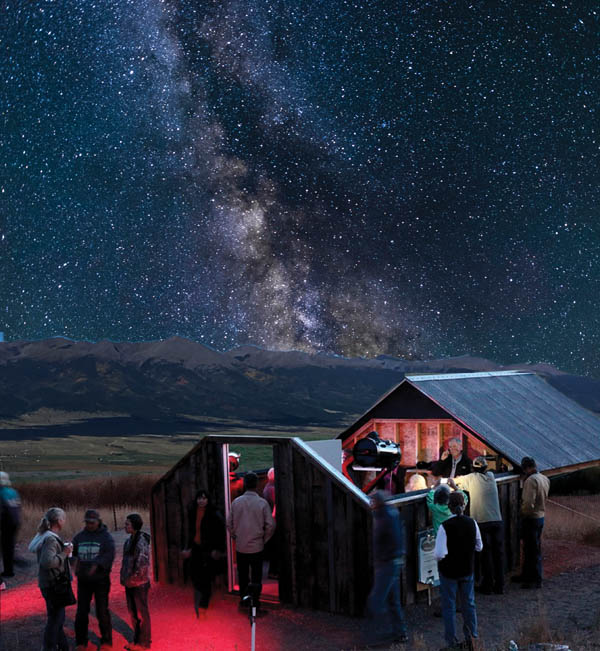How a tiny Colorado community led THE WAY TO THE MILKY WAY

MILKY WAY AS SEEN FROM THE WET MOUNTAIN VALLEY. PHOTO: 3 PEAKS PHOTOGRAPHY
ON A CLEAR NIGHT, illuminated planets, twinkling stars, meteor showers and the spiraling galaxy of the Milky Way, fill the night sky. But most won’t ever see the celestial show in the sky. In the city, the night sky appears to go dark after sunset, but there is an entire other world waiting to be seen if you’re willing to stay up past your bedtime!
Over the years it has become increasingly difficult to see the billions of stars that come out at night, let alone the Milky Way, near any metro area. It is estimated that 80 percent of the population in the United States and Canada live where light pollution blocks the views of the stars and Milky Way, meaning there are many children, let alone adults, who will never witness this rich celestial mosaic.
In order to fully enjoy the night sky and all its beautiful details, typically, one must venture to secluded places in the mountains or travel far from city limits to avoid light pollution. But with efforts led by the International Dark Sky Association, a Dark Sky Community designation brings the show closer to home.
There are currently 33 Dark Sky Communities in the world and the Colorado towns of Westcliffe and Silver Cliff lead the way as the state’s first certified Dark Sky Communities (with the towns of Crestone, Norwood and Ridgway following after). With their commitment to implement special efforts to preserve and protect the night sky, future generations will be able to see the night sky the way our ancestors once did.
To become an IDA International Dark Sky Community the town must show an exceptional dedication to preserving the night sky by adhering to strict implementation and enforcement of quality outdoor lighting ordinances, dark sky education and citizen support. Such steps include adding shielding units to outdoor lights so that light is being directed down and not up, minimizing blue lights, limiting the luminance levels from area signage and numerous others.

Due to their location, nestled between two parallel mountain ranges—the Wet and the Sangre de Cristo mountains—Westcliffe and Silver Cliff are perfectly situated with the surrounding peaks blocking out much of the skyglow from nearby cities such as Pueblo and Colorado Springs. Plus, with an elevation of 8,000 feet, the communities physically sit closer to the stars than any other Dark Sky community in North America, making them the ideal place for stargazing and watching the Geminids meteor shower this December.
The best way to experience the night sky is in Westcliffe with a visit to Bluff Park and the Smokey Jack Observatory. Visitors can arrange a visit or attend one of their dark sky parties to get an up-close look at the moon, colliding galaxies, Saturn’s ring, and exploding stars—all through the state-of-the-art, 14-inch computerized telescope.
Stargazers can also gather on their own at Bluff Park. Overlooking the Wet Mountain Valley and the Sangre de Cristo mountains, the park not only provides picturesque views during the day, but also provides front row seats to the thick blanket of stars that light up the night sky.
The Geminid meteor shower is said to peak on December 13 – 14, 2021 with an impressive 150 or more meteors per hour visible in a dark sky. These meteors are known to be bright and colorful, making them one of the favorites to watch. Whether you plan to watch the meteor shower or just gaze up at the night sky, Westcliffe and Silver Cliff will provide front row seats for the best nightlife experience in Colorado.
LEARN MORE about Westcliffe and Silver Cliff visit darkskiescolorado.org.



